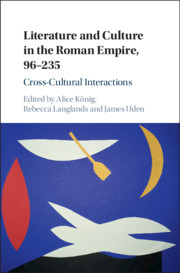Book contents
- Literature and Culture in the Roman Empire, 96–235
- Literature and Culture in the Roman Empire, 96–235
- Copyright page
- Contents
- Figures
- Contributors
- Preface
- Timeline
- Abbreviations
- Map
- Introduction
- Part I Refiguring Roman and Greek Interactions
- Part II Imperial Infrastructure: Documents and Monuments
- Part III Cultural Translation and Transformation
- References
- Index
Introduction
Published online by Cambridge University Press: 28 April 2020
- Literature and Culture in the Roman Empire, 96–235
- Literature and Culture in the Roman Empire, 96–235
- Copyright page
- Contents
- Figures
- Contributors
- Preface
- Timeline
- Abbreviations
- Map
- Introduction
- Part I Refiguring Roman and Greek Interactions
- Part II Imperial Infrastructure: Documents and Monuments
- Part III Cultural Translation and Transformation
- References
- Index
Summary
Introducing the volume to come, this chapter explains the need for new approaches to the study of literary and cultural interactions in the Roman empire that cross linguistic, cultural and religious boundaries. It begins with a brief overview of the diversity of cross-cultural interactions that can be traced, on and off the page, between different individuals and communities in the second century CE. It analyses current and innovative methodologies for studying ‘intertextuality’ in different disciplines, including approaches that amplify gaps or silences, as well as instances of dialogue/cross-fertilisation. It then stresses three ways in which the volume particularly aims to contribute: firstly, by including technical, documentary, epigraphic and oral material in its wide-ranging study of ‘literary’ interactivity; secondly, by stressing the relationship between textual interaction, cultural practices and material aspects of empire; thirdly, by working out from intertextuality to interdiscursivity, shining a spotlight on the migration of ideas as well specific interactions. The introduction ends with a case study – the story of Arion and the dolphin, retold by many ancient authors – that exemplifies the processes of cross-cultural travel and transmission in the ancient world and also the challenges that scholars face in tracing and interpreting such cross-cultural interactions.
Keywords
- Type
- Chapter
- Information
- Literature and Culture in the Roman Empire, 96–235Cross-Cultural Interactions, pp. 1 - 34Publisher: Cambridge University PressPrint publication year: 2020
- 1
- Cited by

